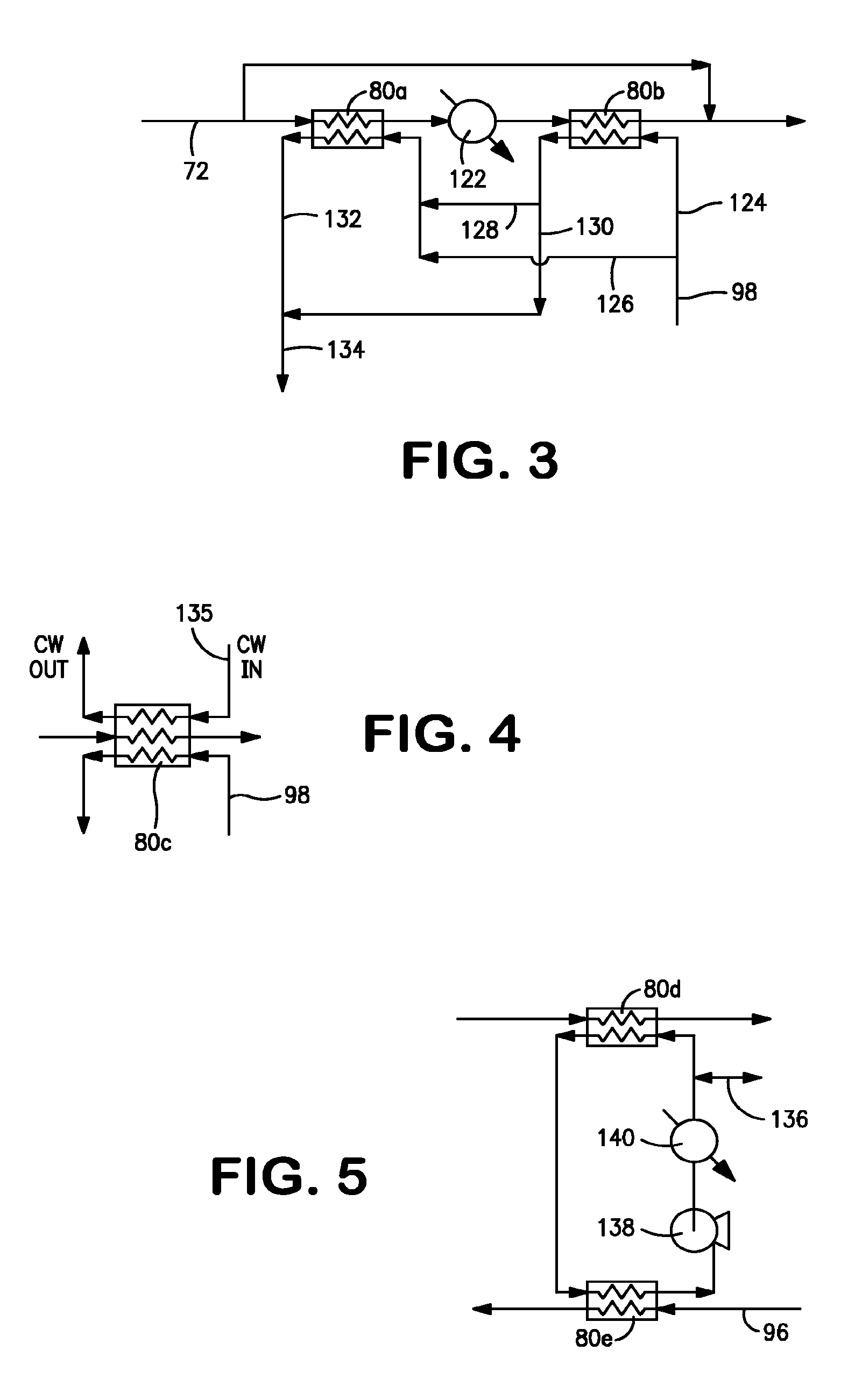Electricity and synthesis gas generation method
a technology of synthesis gas and electricity, applied in the direction of electrochemical generators, machines/engines, turbine/propulsion fuel heating, etc., can solve the problems of electricity production costs, and achieve the effects of reducing the fuel requirements of gas turbines, economic efficiencies, and reducing the cost of electricity production
- Summary
- Abstract
- Description
- Claims
- Application Information
AI Technical Summary
Benefits of technology
Problems solved by technology
Method used
Image
Examples
example 1
[0034]For purposes of this example, synthesis gas stream 72 has a flow rate of about 860 lb-mol / hr and has the following composition: 48 mol percent hydrogen, 35.7 mol percent water, 1.9 mol percent carbon monoxide, 10.8 mol percent carbon dioxide, 0.6 mol percent nitrogen and 3.0 mol percent methane. After passage through heat exchanger 74, synthesis gas stream 72 has a pressure of about 238 psia and a temperature of about 372° F. Assuming a hydrogen recovery of about 83 percent, approximately 3.12 MMSCFD hydrogen would be produced for hydrogen product stream 90. In heat exchanger 80, the synthesis gas stream 72 is further cooled to 100° F. against subsidiary stream 98 that constitutes about 62 percent of combined stream 96. Subsidiary stream 98 emerges from heat exchanger 80 at a temperature of about 322° F., which upon mixing with subsidiary stream 100, produces fuel stream 106 at a temperature of about 227° F. In this example no additional fuel is used and hence, subsidiary fuel...
example 2
[0035]This example is a modification of Example 1 in which synthesis gas stream 72 has a flow rate of about 1385 lb-mol / hr and the same composition and temperature and pressure after having been cooled in heat exchanger 74. Again, assuming a recovery of hydrogen of about 83 percent, about 5.02 MMSCFD hydrogen would be produced for hydrogen product stream 90. Furthermore, in this example it is assumed that all of fuel stream 84 passes through heat exchanger 80 to cool synthesis gas stream 72 to about 100° F. The resultant fuel stream 106 has a temperature of about 322° F., which decreases fuel consumption by about 0.76 percent.
example 3
[0036]This example is similar to that of Example 2, but with synthesis gas stream 72 having a different composition than that previously considered due to additional process heat recovery within water gas shift unit 70. In this regard, for purposes of this example, synthesis gas stream 72 is assumed to have the following composition: 63.9 mol percent hydrogen, 13.2 mol percent water, 2.8 mol percent carbon monoxide, 14.1 mol percent carbon dioxide, 0.7 mol percent nitrogen and 5.3 mol percent methane. As a result of the additional process heat recovery, synthesis gas stream 72 has a lower stream temperature after heat exchanger 74, namely 277° F. as opposed to 372° F. in the previous examples and consequently a lower moisture content due to condensation removed in an upstream knock-out drum that as would be known in the art could be associated with water gas shift unit 70. Further, in this example, synthesis gas stream 72 must only be cooled from about 277° F. to about 110° F. As su...
PUM
 Login to View More
Login to View More Abstract
Description
Claims
Application Information
 Login to View More
Login to View More - R&D
- Intellectual Property
- Life Sciences
- Materials
- Tech Scout
- Unparalleled Data Quality
- Higher Quality Content
- 60% Fewer Hallucinations
Browse by: Latest US Patents, China's latest patents, Technical Efficacy Thesaurus, Application Domain, Technology Topic, Popular Technical Reports.
© 2025 PatSnap. All rights reserved.Legal|Privacy policy|Modern Slavery Act Transparency Statement|Sitemap|About US| Contact US: help@patsnap.com



